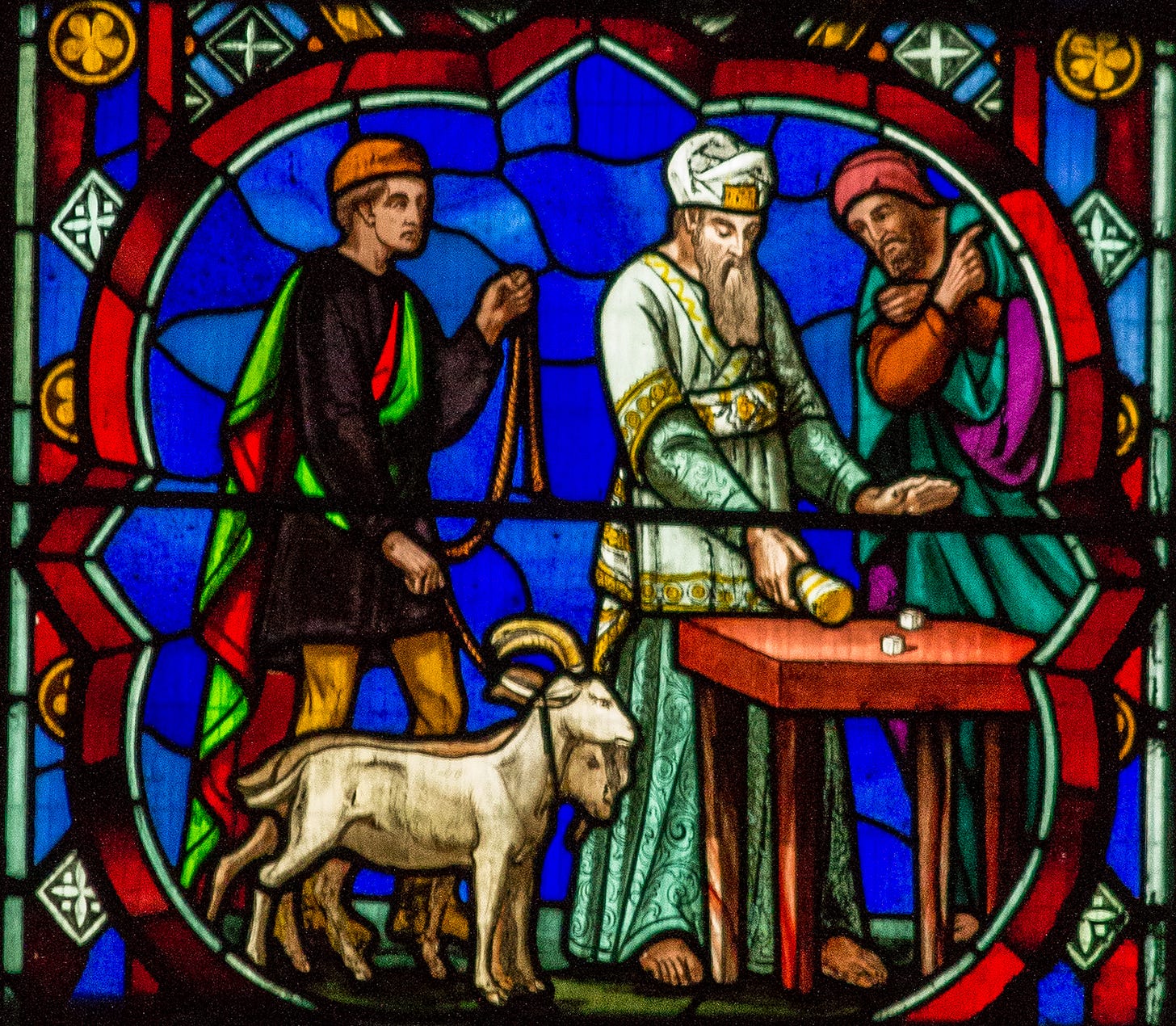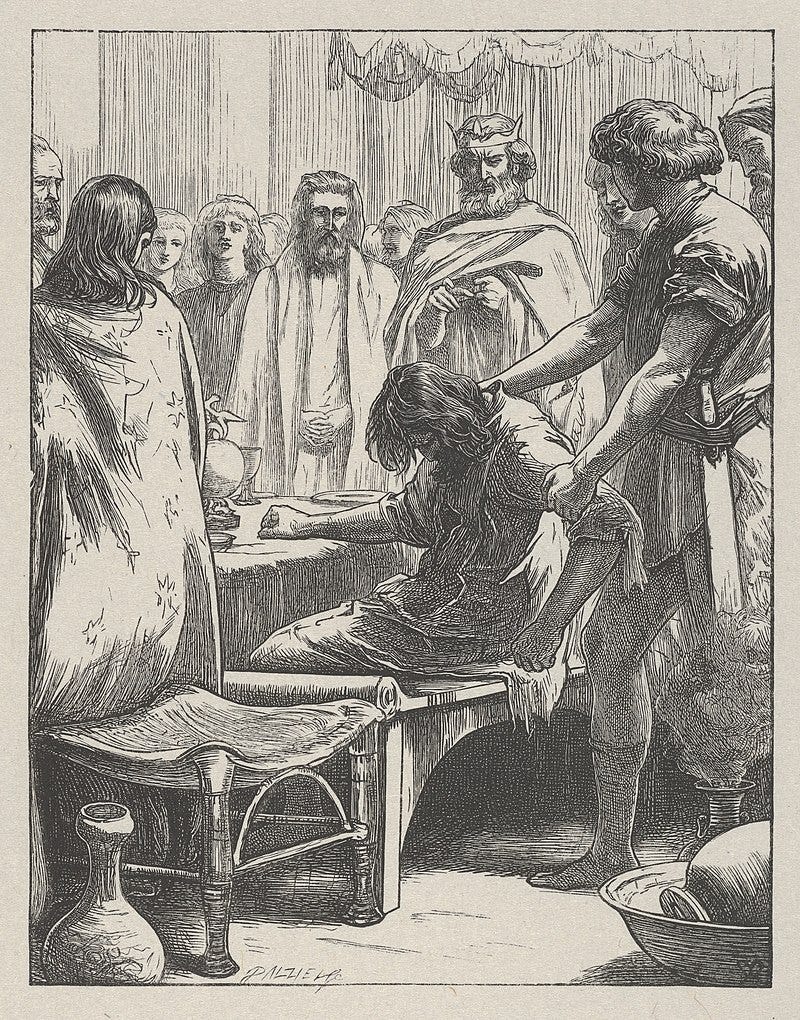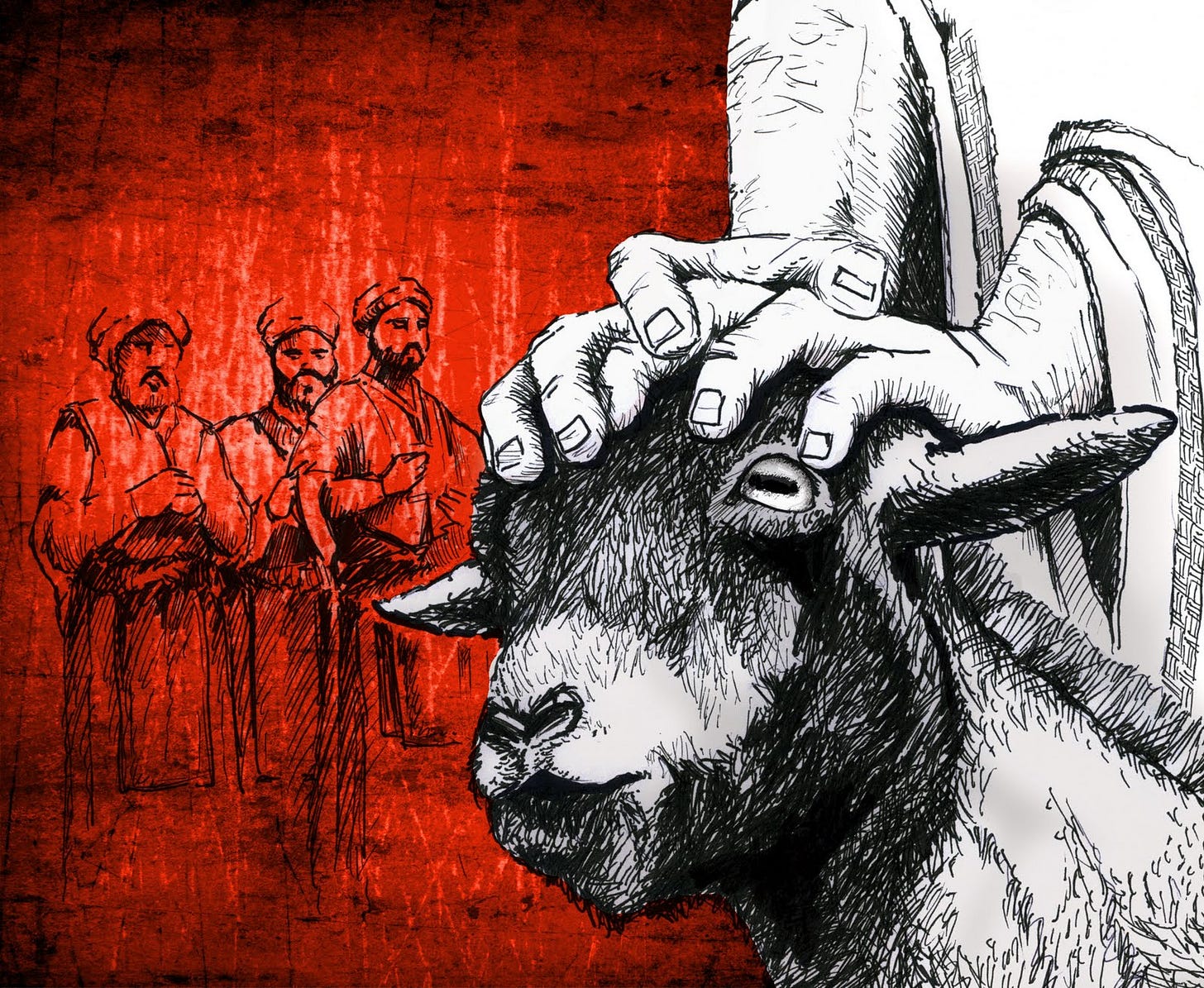Several months ago, one of my Substack readers wanted my opinion on the guest who had no wedding garment and was thrown out in the Parable of the Wedding Feast in Matthew 22. It was a difficult topic and I couldn’t come up with a satisfactory answer. Well, I just came across something that may throw a little light on Matthew 22:13.
I had heard or read a teaching on Matt. 22 a few months ago, and the teacher pointed out that the phrase "bind him hand and foot" seemed to be added to the text, as it is missing in many manuscripts.
But I found the phrase in the book of Enoch, chapter 10, so perhaps it was removed from several manuscripts because the context in a post-Second Temple world had been lost. So I wonder if Jesus was quoting from the book of Enoch. They refer to Azazel, the fallen angel who taught men how to make weapons of war, and women to make mirrors and use makeup to allure men. The context is the Flood that is about to come on the earth; the following actions are to be done in preparation before the Flood.
Enoch 10:4-8
4 The Lord said to Raphael, "Bind Azazel hand and foot and cast him into the darkness. Make an opening in the desert, which is in Dudael (called Beit HaDudo in the Mishna Talmud, meaning "cauldron of God"), and bind him there.
5 And place upon him rough and jagged rocks, and cover him with darkness, and let him abide there forever, and cover his face that he may not see light.
6 And on the day of the great judgment, he will be cast into the fire.
7 And heal the earth which the angels have corrupted (see Heb. 2:5), and proclaim the healing of the earth, that I will heal it, so that not all the children of men perish through all the secret things that the Watchers have disclosed and have taught their sons.
8 The whole earth has been corrupted through the works that were taught by Azazel, so ascribe all these sins to him."
👆Hold that last thought until I get to Leviticus 16.
Back to Matthew 22:13. It comes at the end of the Parable of the Wedding Feast:
Matt 22:11-14 NKJV
11 "But when the king came in to see the guests, he saw a man there who did not have on a wedding garment.
12 "So he said to him, 'Friend, how did you come in here without a wedding garment?' And he was speechless.
13 "Then the king said to the servants, 'Bind him hand and foot, take him away, and cast [him] into outer darkness; there will be weeping and gnashing of teeth.'
14 "For many are called, but few [are] chosen."
The "outer darkness" seems to be reserved for the nation of Israel. Here are two other references in Matthew that specifically pertain to the judgment of Israel:
Matt 8:12 NKJV "But the sons of the kingdom will be cast out into outer darkness. There will be weeping and gnashing of teeth."
Matt 25:30 NKJV 'And cast the unprofitable servant into the outer darkness. There will be weeping and gnashing of teeth.'
Okay, now back to the Azazel goat:
The only uses of the word "azazel" in the Bible are in Leviticus 16, regarding the Day of Atonement, or Yom Kippur. It is translated "scapegoat" in English, which demonstrates that the English translators had an imperfect understanding of the Azazel goat ritual.
There are two goats in Leviticus 16—one was the Lord's, and it was killed as a sin offering. The other was Azazel's, and all the sins of Israel for that year were transferred to it by the laying on of the chief priest's hands (remember, he wears a turban with "Holiness to the Lord" engraved on a plate and tied onto the turban, for the express purpose of bearing "the iniquity of the holy things" for all Israel, see Exodus 28:36-38). This is where the context of Enoch 10 makes sense; the knowledge of how to sin was the fault of Azazel, “so ascribe all these sins to him.” Aaron (or the chief priest) takes on Israel’s sins, but then lays all these sins on the second goat.
Then the Azazel goat was taken to a place in the desert.
Lev 16:20-22 NKJV
20 "And when he has made an end of atoning for the Holy [Place], the tabernacle of meeting, and the altar, he shall bring the live goat.
21 "Aaron shall lay both his hands on the head of the live goat, confess over it all the iniquities of the children of Israel, and all their transgressions, concerning all their sins, putting them on the head of the goat, and shall send [it] away into the wilderness by the hand of a suitable man.
22 "The goat shall bear on itself all their iniquities to an uninhabited land; and he shall release the goat in the wilderness.
So, reasoning from the information in Enoch 10, the live goat bearing Israel's sins was sent to the same place that Azazel was imprisoned, Dudael, a.k.a. Beit HaDuda. The Talmud expands on the ritual:
And they made a ramp for the goat due to the Babylonian Jews who were in Jerusalem, who would pluck at the goat’s hair and would say to the goat: Take our sins and go, take our sins and go, and do not leave them with us. People from among the prominent residents of Jerusalem would escort the one leading the goat until they reached the first booth. Booths were set up along the path to the wilderness to provide the escort a place to rest. There were ten booths from Jerusalem to the cliff, with a distance of ninety ris between them. As there are seven and a half ris for each mil, the total distance was twelve mil. —sefaria.org
Another source suggests the distance was more like 3 miles. Either way, it was more than 2000 cubits, the distance a man could legally walk on Yom Kippur, which was governed by the same Shabbat rules regarding traveling.
After the confession over the scapegoat, the priest passed the goat to the one who was to lead it to the wilderness. According to the halakha, everyone is eligible to lead it, but the High Priests established a fixed custom and did not allow an Israelite to lead it. Rabbi Yosei said: That was not always the case. There was an incident where a person named Arsela led the goat to the wilderness, and he was an Israelite. —sefaria.org
No doubt the issue was how far the Law permitted a man to walk, but Lev. 16:21 calls this person a "suitable, fit, opportune, or timely man," which suggests that a non-Israelite was the one to carry the sin-bearing goat to Azazel's desert. Did they grab someone off the street, like Simon of Cyrene, to carry the burden of sin away from Israel?
That would certainly better explain the appearance of Simon of Cyrene in the account of the Crucifixion.
Lev 16:21 NKJV "Aaron shall lay both his hands on the head of the live goat, confess over it all the iniquities of the children of Israel, and all their transgressions, concerning all their sins, putting them on the head of the goat, and shall send [it] away into the wilderness by the hand of a suitable man.”
Matt 27:32 NKJV Now as they came out, they found a man of Cyrene, Simon by name. Him they compelled to bear His cross.
Was Simon a prophetic reference pointing to the Azazel goat ritual, a reminder that Jesus was the Lord's goat and must die as a sin offering to forgive sins, but that he was not the burden-bearing Azazel goat who was given over to the fallen angel along with the sins of Israel? Something to think about.
Meanwhile, the Azazel goat was tied with a scarlet cord that would turn white when the full weight of the goat stretched it out. No doubt the cord was of woven or braided material and then dyed, so that under stress the inner white fibers of the cord would become visible and the cord would change color.
What did the one designated to dispatch the goat do there? He divided a strip of crimson into two parts, half of the strip tied to the rock, and half of it tied between the two horns of the goat. And he pushed the goat backward, and it rolls and descends. And it would not reach halfway down the mountain until it was torn limb from limb. —sefaria.org
The Talmud reports that the red cord that bound the Azazel goat failed to turn white beginning about the time of Jesus’ death and resurrection until the destruction of the Temple in 70 A.D., which is interesting:
"The Sages taught: During the tenure of Shimon HaTzaddik, the lot for God always arose in the High Priest's right hand; after his death, it occurred only occasionally; but during the forty years prior to the destruction of the Second Temple, the lot for God did not arise in the High Priest’s right hand at all. So too, the strip of crimson wool that was tied to the head of the goat that was sent to Azazel did not turn white, and the westernmost lamp of the candelabrum did not burn continually." - Talmud, Tractate Yoma 39b, as translated by William Davidson.
Apparently the sins of Israel were no longer removed in the old way once the Age of Grace began in 32 A.D., and God clearly informed them of this for some forty years before the Second Temple was destroyed.
So what I have learned is that after the judgment of all Israel, described by Jesus in Matthew 25:14-30, the unrepentant Israelite sinners will be the sin offering to Azazel when they all go into the lake of fire together (no doubt the fallen angel Azazel was imprisoned in or near the crack of doom that opens up on the eastern side of Mt. Zion at the Second Coming).
I also learned that Jesus died for the sin of the whole world, but He did not have to carry the burden of Israel’s sin to Azazel, because He was not the sin but the Lord’s unblemished sacrifice, and His death forgave repented sins—wiped them out for all time! Hallelujah!
And finally, to return to the wedding feast and the guest who had misrepresented himself as a believer in Jesus the Messiah in Matt. 22:12, it seems that he is an Israelite who says he believes in Jesus as his Savior—but he has been given no wedding garment. He is not a member of the Bride, the Body of Christ. He is, in fact, an unrepentant sinner who does not have true faith in Jesus, so he will be cast into the outer darkness and lake of fire with Azazel…"where there shall be weeping and gnashing of teeth."
As a half-Jew and repentant sinner who is saved by faith in Yeshua, I pray my Jewish brethren who are not sincere about their conversions will repent of their expedient deception before it is too late. The appointed time is almost here.
###







